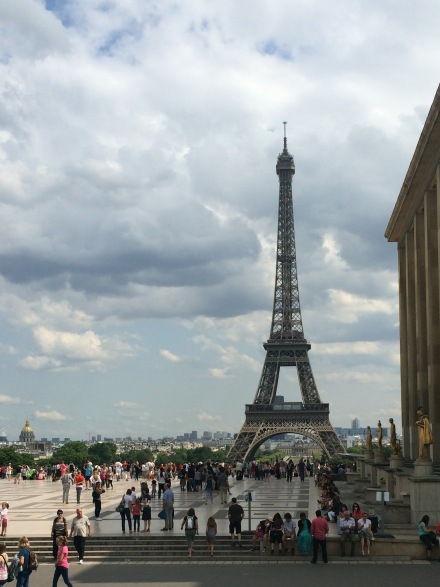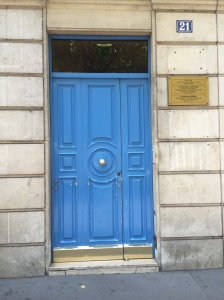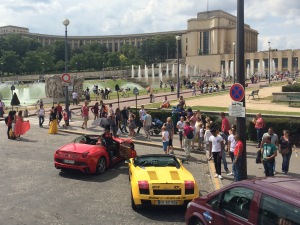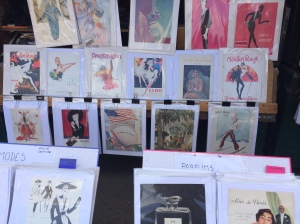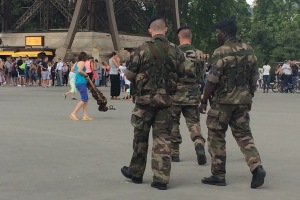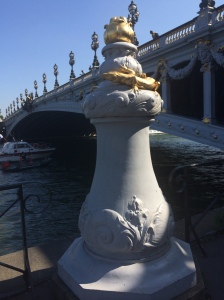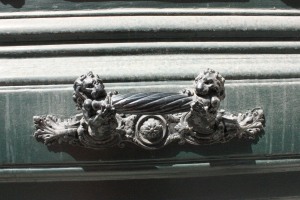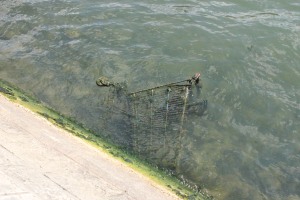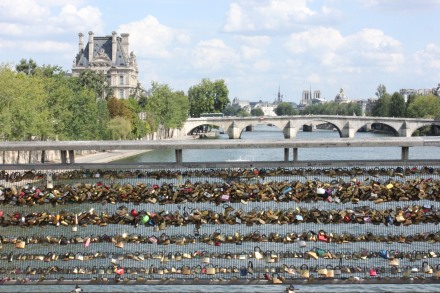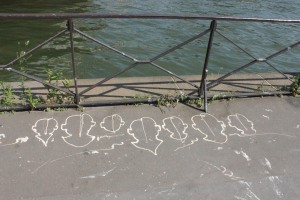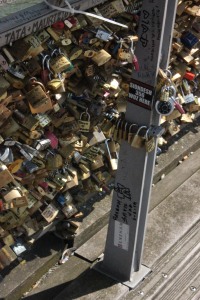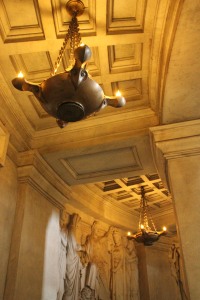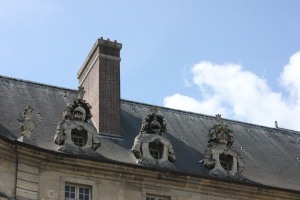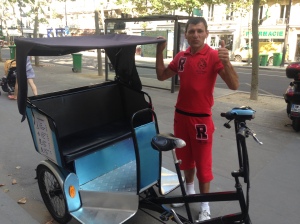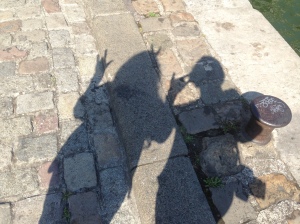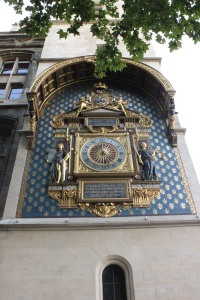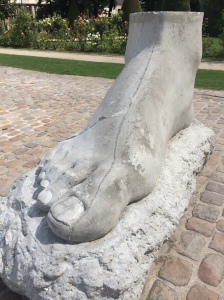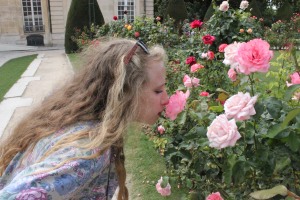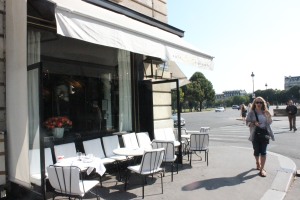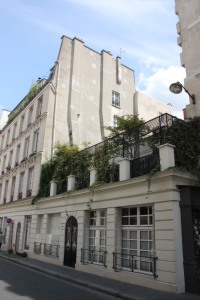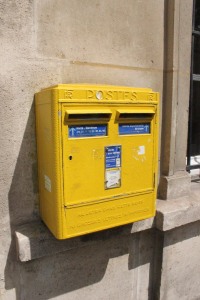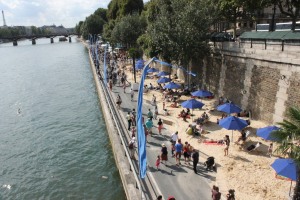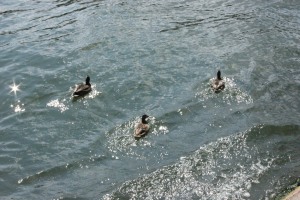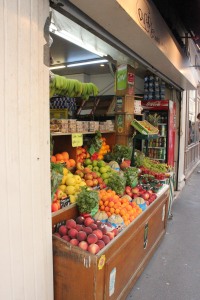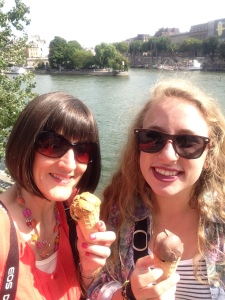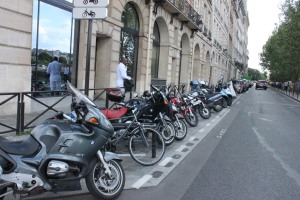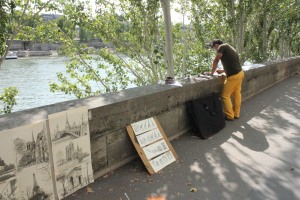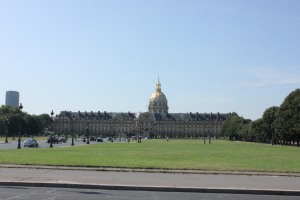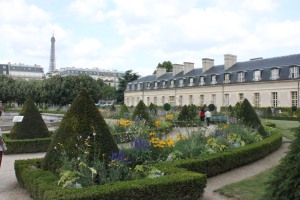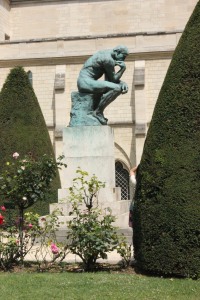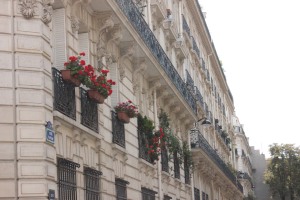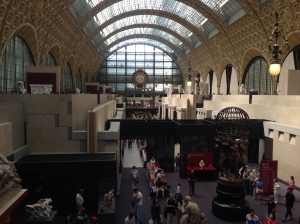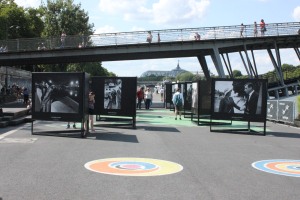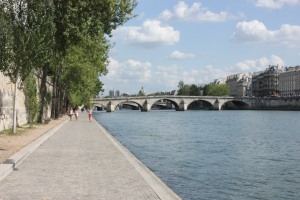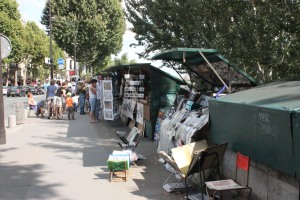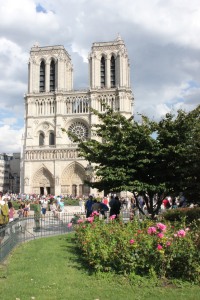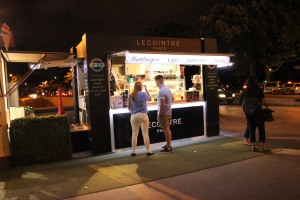We spent the morning touring Les Invalides and strolling along the Seine, after which we set out on foot to the Musée d’Orsay. We had settled on that gallery for two reasons: 1) it was Tuesday and the Louvre was closed, and 2) Impressionist art is my favorite. Somewhere between Eglise du Dome and the Orsay we got off track and ended up near Musée Rodin. Since we were in the neighborhood, it seemed only right to stop in for a quick peek at Le Penseur—better known in American circles as The Thinker. This happenstance visit resulted in a most delightful experience! Rodin’s artwork and sculptures are on display in the Hôtel Biron (which he used as his workshop from 1908 until his death in 1917), as well as inside a converted chapel on the property and throughout the seven-and-a-half acre garden. Our Paris Museum Pass came in handy once again, allowing us to skip the queue and go right in. Since our time was limited, we glanced into the chapel museum then went directly to the gardens. Our first stop was The Thinker—which you may not realize originated as the central figure of Rodin’s rendition of Dante’s Gates of Hell (which can also be seen in the garden). After a couple of cheesy “thinker” snapshots, we made the rounds of the gardens—smelling the roses, observing sculptures which Rodin placed in the gardens himself, viewing the Marble Gallery, admiring the perfectly manicured lawn, and drinking in the gorgeous landscape! We made a pass through the gift shop as we were leaving. (There is also a cafe on the property.) Musée Rodin is definitely worthy of a visit, whether extended or brief. So glad we veered slightly off-course…
travel europe
The Eiffel Tower Experience: A Photo Essay
As long as I can remember I have associated Paris with the Eiffel Tower, and the Eiffel Tower with Paris. Visiting this iconic landmark was the highlight of my trip to France’s capital city…and undoubtedly the most photographed of my experiences abroad! Click on individual photos below for larger views.
Rue Cler…Paris’ Famous Market Street
I was excited to discover Rue Cler right around the corner from our hotel in the 7th arrondissement! We arrived in Paris right at lunch time so decided to check out the cafes along this inviting market street. The smooth cobblestones, wrought iron balconies, and window boxes overflowing with brightly colored flowers provided the perfect backdrop for a midday stroll. Generally speaking, Rue Cler is limited to pedestrian traffic which makes it all the more appealing. Our schedule did not allow for the leisurely perusal of the patisseries, chocolatiers, fromageries, delicatessens, and other shops that I wished for, but we did grab a bite to eat at Cafe du Marche’, situated on the corner of Rue du champ du Mars and Rue Cler. I did not know at the time that this cafe is one of the most popular in the area…we chose it simply for its aesthetic appeal (it is the cutest sidewalk cafe with red chairs and delightful awnings) and because the food looked good! Daily specials were written on large chalkboards. Since our French is a bit rusty—code for nonexistent—we made an educated guess and ended up with a couple of delicious entrees. I couldn’t tell you the actual names of the dishes, but I had vegetarian quiche and a green salad while my niece had what appeared to be the French version of a Cobb salad. Our waitress was attentive and we managed to communicate even though she spoke not a word of English and we speak no French. Apparently gratuity is not customary—at least there was no space to add it on to the check—so I handed it to her in person. Those cultural differences can be a bit tricky, but the American in me insists that I tip for good service. After a full afternoon and evening of sightseeing, we returned to Rue Cler for supper and you know the old saying: When in Paris, eat Chinese. Okay, so that’s not exactly how it goes…but I gave my niece free choice and she chose Chinese. It was decent, and best of all…the service was quick and we were able to zip back to the hotel and fall into bed before heading out for another busy day of sightseeing!
Read more about Rue Cler…
Paris Sightseeing Tips: The Famous Rue Cler Open Market Street
Completely Random Paris…Part 3
A few more random photos from around Paris…
Blue Door…
Drawing a Crowd…
Marble Beauty…
Perusing les Bouquinistes…
Hieroglyphics…
Ground Level of the Eiffel Tower…
Pont Alexandre III…
This is the life…
Elaborate Door Hardware…
And…a shopping cart in the Seine…
Stop in the Name of Love…Locks
I had heard about Paris’ famous “Lock Bridge” and was anxious to see it. I soon discovered, however, that there is not just one! A number of bridges have been transformed into “lock bridges” in recent years…and not just in Paris. Couples have taken to writing or engraving their names or initials on padlocks (love locks) and attaching them to the bridge railings, then throwing the keys into the Seine River as a pledge of their undying love to one another. We saw several vendors selling locks on and around the bridges, making it convenient to join this cult craze. As romantic as this all may seem, the locks are causing big problems—even leading to the collapse of at least one bridge railing on the original “lock bridge,” the Pont des Arts. Because of that, the city of Paris has implemented safety measures—replacing the railings in some places with glass panels—and has kicked off a publicity campaign on Twitter called #lovewithoutlinks. The idea is for couples to photograph themselves on the bridge and post pics on Twitter with the campaign hashtag rather than going the love locks route. It remains to be seen whether or not an online photo will prove a satisfactory substitute for a lock and key…and how quickly the bridge railings are replaced entirely with glass panels.
An interesting side note… During our tour of the Eiffel Tower, our bags were checked for illegal contraband…including padlocks! It seems that couples were smuggling in padlocks and fastening them onto the famous monument—an eyesore and safety concern all rolled up in one!
Completely Random Paris…Part 2
More random photos shot around and about in Paris…
Sidewalk Graffiti…
Locks, Locks, and More Locks…
Lanterns in the Crypt…
Windows with Character…
Pedi Cab Driver from Romania…
Shadow Selfie…
Quite the Clock…
Big Foot…
Bicycles and Signage…
French Version of an American Favorite…
Did you miss Completely Random Paris…Part 1?
Completely Random Paris…Part 1
There is so much to see, experience, and love in Paris! Here are a few random shots that struck my fancy for whatever reason…
Sidewalk Cafe…
Rooftop Garden…
Yellow Post Box…
Beach in the Middle of the City…
Window Shopping…
Ducks and Sunshine on the Seine…
Gargoyle Rain Spouts…
Sidewalk Market…
Ice Cream Selfie…
That Random Winnie the Pooh on the Fence…
Motorcycle Parking…
Artists Who May or May Not Actually Know How to Draw…
To be continued…
Paris In a Day and a Half…Day 2
After a somewhat strenuous sightseeing scheule our first day in Paris, we slept in a bit on Day 2. We ate breakfast at our hotel then set off on foot around 10:00 a.m., aware that, once again, we must prioritize in order to make the best use of our time. We put in another twelve hour day as follows…
- We began the day by exploring the area on and around Pont Alexandre III—also known as the Bridge of Golden Statues. From a distance, the bridge doesn’t appear all that impressive due to its low profile—which was intentional so as not to obstruct the view on the Invalides and Champs-Elysées. However, a walk across the bridge and below it along the banks of the Seine reveals its opulent and intricate design. The sun glistening off of the gold leaf is quite a magnificent sight! The wide walkways on both sides of the bridge offer great views of the river. After walking across the bridge and back, we descended the stairs and looked at the underside of the bridge. (The entrance to the Invalides metro station is located under the staircase.) Back up on street level, we viewed the Children’s Statue of Lafayette just beyond the Pont Alexandre III. In the same area are the Grand Palais and the Petit Palais (which houses the City of Paris Museum of Fine Arts). Sadly, we did not have time to visit either of those.
- From Pont Alexandre III, we strolled back along the Esplanade des Invalides with its lovely grassy expanse where many people were enjoying the sunshine and the lovely Paris views. (As you would expect, you can see the Eiffel Tower from most anywhere in this area.)
- Our next stop was the Musee de l’Armee (Army Museum)/Hotel National des Invalides. This building is truly gargantuan! There is artillery positioned along the front perimeter of the complex, as well as inside the huge courtyard. We looked at all of this in passing but did not actually enter the museum itself because of—you guessed it—a shortage of time. We passed through to the Eglise du Dome, which houses Napoleon’s tomb, the “Soldier’s Chapel,” a magnificent frescoed dome, and various other items of religious and historical significance. Our Museum Pass allowed us to go right in. The tour is self-guided and photos are allowed—always important to me. Napoleon’s sarcophagus is unbelievably gigantic—a testament to the larger-than-life image projected by the tiny Emperor. The opulently decorated altar and de la Fosse’s gorgeous paintings inside the dome are worthy of inspection, and a brief glance into the various chapels is recommended. The most interesting area to me, however, is the crypt which contains Napoleon’s coffin as well as a number of symbolic elements (the marble floor, twelve “Victories” scultures, and ten bas-reliefs) related to Napoleon’s reign and the Empire’s military victories. When you have finished perusing the church, exit through the elaborate gilded doors toward Place Vauban and Avenue de Tourville. (We allowed between half and hour and forty-five minutes for this stop.) We took time to visit the small snack shop and purchase a drink for the road.
- Directly to your right, you will see a row of trees. Beyond that is the Jardin de l’Intendant (Garden of the Steward)—our next stop. This 18th-century garden has a classically French design and includes a large pool and fountain (sadly, dry during our visit) as well as cone-shaped yew bushes, brightly colored flowers, walking paths, benches for contemplation, and a statue of Jues Hardouin-Mansart, designer of Eglise du Dome. This garden is attached to a functioning hospital—for veterans, I believe—and was occupied by a number of patients and their families. A great place for quiet contemplation if time had allowed.
- Next, we walked to Musee Rodin. (A reliable mapping app—or a good map book—is a must if you want to maximize your time by taking direct routes between attractions.) When we arrived at the museum, the line was really long, stretching halfway down the block. Thanks to our Museum Pass we were able to skip the queue and walk right in! After a quick glance into the chapel museum, we made our way out into the garden. (Time constraints prohibited us from touring Hotel Biron, the main building.) We made a beeline straight to “Le Penseur”—better known to most people as The Thinker. Somehow I didn’t expect it to be outdoors in the elements, but there it was! Of course, we had to take time to pose for a couple of “thinking” photos. Fortunately, the line wasn’t very long. We viewed the Marble Gallery, Dante’s The Gates of Hell, various sculptures located throughout the gardens, an abundance of fragrant roses, walking paths, water features, a reflecting pool, and sweeping vistas between the Hotel Biron and a trellised garden at the opposite end of the property. This would be a wonderful place for relaxation and contemplation—if only one had the time! There is a cafe onsite as well as a nice gift shop, which we perused briefly before moving on.
- As we walked between the Rodin and the Musee d’Orsay, we took time to photograph various sights—and sites—of interest. This included a sidewalk produce market, decorative door hardware, a rooftop terrace, a bright yellow post box, Ministere de la Defense, shops and cafes, bright red geraniums growing in flower boxes high above the street, and wrought iron balconies with clothing hung out to dry. As we learned, every square inch of Paris provides sightseeing opportunities!
- We arrived at Musee d’Orsay just before 2:00 p.m. Once again, our Museum Pass paid off as we skipped another long queue and went right inside. (Have I mentioned that the Paris Museum Pass is a wise purchase?!?) Since we had not eaten lunch, we opted to go directly to Level 5 and try our luck at Cafe Campana. After a brief wait, we were seated and served. The food was neither great nor terrible, but the convenience factor made it just right! After our meal, we exited the cafe onto an observation balcony overlooking the Seine. It provided an incredible view of not only the river, but also the Tuilleries Garden and the Louvre. I got some great photos! Obviously, there was no way we could tour the entire museum and still see more of Paris so we chose the Impressionist Gallery. It was of greatest interest to us, containing paintings by Degas, Monet, Manet, Renoir, Cezanne, and others. It was quite awe-inspiring to see the originals of so many famous works of art! From there we went to ground level and viewed the sculptural collection. The museum itself—formerly a train station—is an architectural marvel with glass paneled walls and a glass ceiling. Photos are not allowed inside the museum, but from the walkways on the upper levels you can look through small openings for a great view of the Great Hall. (Many people use this vantage point as a photographic opportunity. I may or may not have been one of those people!) My favorite feature of the museum is the majestic Musee d’Orsay Clock which is giant and overlooks the Great Hall. The Orsay has a nice gift shop near the main entrance.
- Just down from the Musee d’Orsay on the left bank of the Seine, we ran across an art exhibit sponsored by Paris Match magazine. Entitled Les Stars et La Seine, this outdoor display includes enlarged versions of black and white photographs from the magazine’s archives. Photos highlight stars from various decades and countries posing along or near the Seine. Celebrities include Frank Sinatra, Joanne Woodward and Paul Newman, Rudolf Noureev, Candice Bergen, and many others. It was a fascinating and unexpected find. (No idea if this was a temporary exhibit or something that stays there all the time.)
- We crossed the Passerelle de Solferino, which links the Orsay to the Tuilleries Gardens. The bridge itself is a sight to see…double-decker in design with steps below and smooth planking above. The two levels converge at the top where people were seated on benches or standing against the railing looking out over the river. Several street musicians had staked a claim on the bridge as well. The railings are almost entirely covered with padlocks…an intriguing development that I will address in a future post.
- Once we reached the right bank, we took time to stroll along the river. Below street level, it was serene and quiet. The only other people around were fellow walkers and the occasional tour boat. Walking on this level allowed us to view the many bridges from a different perspective. Each one has its own unique characteristics and personality.
- We returned to street level near Place du Carrousel and viewed La Grande Roue (a giant Ferris wheel in the Tuilleries Gardents) and then the Arc de Triomphe du Carrousel. There were a lot of street vendors in this area, but most were not aggressive. We passed under the arch and into the courtyard of the Louvre, but didn’t actually go inside the famous museum—not only due to time constraints, but also because we were there on a Tuesday and it was closed.
- Our next destination was Notre Dame Cathedral. Between the Louvre and Notre Dame, we sort of zig-zagged back and forth between the left and right banks, crossing bridges and then re-crossing the river further down. We saw a number of street artists (not sure how many were authentic since the artwork they had on display was exactly like that of ninety-nine other “artists”), les Bouquinistes (booksellers), vendors (we sprung for ice cream), and the half-mile long “Paris Plage” (Paris Beach). We also paused to see Pont des Arts (the original “lock bridge”), Pont Neuf (the “New Bridge”), and La Conciergerie (prison home of doomed Mary Antoinette).
- We arrived at Notre Dame around 5:30 p.m. to find the square jam-packed with tourists. The Museum Pass does not apply at Notre Dame, so we contented ourselves with viewing the exterior of the cathedral and listening to the bells chime on the half hour. We hired a pedi-cab to take us back to our hotel where we rested for about an hour and a half before setting off on foot to the Eiffel Tower area for our night riverboat cruise on the Seine.
- We got a little off-course and ended up at a street market near the base of the Eiffel Tower. The area was sprinkled with white tents containing food and a variety of wares from around the world. My niece was thrilled with her purchase—a pair of Turkish-style pants! The market had the feel of a middle eastern bazaar.
- Our last experience of the day was a riverboat cruise on the Seine. We purchased our tickets in advance along with admission tickets for the Eiffel Tower. The cruise started at dusk and ended in full darkness. We began at the base of the Eiffel Tower and boated as far as Pont Alexandre III before turning around and heading toward Il de la Cite. Just beyond Notre Dame we turned back and returned to the Eiffel Tower just in time for the light show spectacular at the top of the hour—in our case, 9:00 p.m. The nighttime cruise is on my Top 5 list for Paris—definitely worthwhile regardless of how long or short your visit. Seeing Paris lit up at night is a beautiful sight!
- When we disembarked, we bought a few souvenirs at a little shop near the landing then walked over to the Tower to get a few night shots…see previous post for details on this “no-no.” Afterward, we picked up sandwiches and drinks from a nearby food kiosk and caught a cab back to the hotel.
It was a lot to cram into two days, but we saw more of Paris than I had dared to hope by prioritizing and eliminating activities to fit our tight schedule. As it turned out, we were stranded in Paris (at the airport, to be exact) for almost an entire additional day, but that is a story for another time…
Don’t miss our Day 1 itinerary.
Paris In a Day and a Half…Day 1
If you find yourself with a “spare” day and a half—not counting travel time—is it worth it to try to see Paris? I wondered the same thing myself when I had the opportunity to tack a quick visit onto the front-side of a trip to Ireland. It is indeed possible, but be prepared to prioritize and make some tough decisions in order to maximize your limited time.
I did as much planning ahead as possible—making the hotel reservation, booking tickets for several attractions, and mapping out a tentative touring schedule and route.
Day 1 Itinerary:
- Our flight arrived in Paris at 9:00 a.m. and we hit the ground running. For whatever reason, I am never able to sleep in-flight—a circumstance that is terribly aggravating—so I was fairly tired on top of the jet lag that first day. There was no time for rest, however, so we pushed on. I had arranged for a shuttle from Charles de Gaulle Airport to our hotel and the driver was waiting to whisk us away as soon as we grabbed our luggage. [Prior to meeting him, we withdrew money (in euros, of course) from the airport ATM machine (distributeur in French). This is the best option if you want to avoid terrible exchange rates and an astronomical commission charge at Travelex or similar exchange agencies. We also stopped by one of the airport T1 desks and purchased Paris Museum Passes.]
- We were checking into our hotel by 11:00 a.m., Paris time.
- After freshening up a bit, we headed around the corner from our hotel to eat lunch on Rue Cler. The restaurant choices are diverse and plentiful on this delightful, cobblestone thoroughfare, so we made a pass up and back before settling on Cafe’ du Marche’ for our first sampling of French cuisine. This popular cafe’ offers sidewalk seating, so we had an opportunity to people-watch while enjoying our meal. (More about Cafe’ du Marche’ in a future post.) Then we began our sightseeing in earnest…
- Sightseeing on Foot – We walked from our hotel to Les Invalides and then on to Pont Alexandre III (the Bridge of Golden Statues) in search of a tour bus stop. We didn’t follow a pre-planned route…just walked wherever our feet carried us. We saw a number of high-end stores, cute cafes with red-and-white striped awnings and umbrellas, and lots of fabulous French architecture.
- L’Open Tour – We purchased passes online in advance for this hop on-hop off, open-top double-decker bus tour. There are 50 stops along the route as well as multilingual commentary. In theory, this is a great way to see the city; in reality, there is a downside. We visited Paris in August and though it wasn’t nearly as crowded as I had feared, we had difficulty finding a tour bus with available space—especially in the upper deck for the best view—and often had to wait until the third or fourth bus, go to another stop, or settle for touring on foot. That said, the view of the Arc de Triomphe from the open-air, top deck was far better than anything we could have seen from the ground. Ditto the view of the Eiffel Tower from the Trocadéro…got some wonderful photos of both. It was a great way to see the Champs-Élysées and Place de la Concorde as well. All in all, worth the money…just be prepared for delays during heavy tourist times.
- Eiffel Tower – We ended our bus tour near the Eiffel Tower, then went to pick up our admission tickets. (If you wish to go to the top of the Eiffel Tower—or even visit the lower decks—you need to purchase tickets through the official web site well in advance. I did not do that so ended up booking (still in advance) through Paris Easy Pass Tours, which costs a bit more but has the benefit of an actual tour guide.) We met up with our group at the designated location and accompanied our guide to the tower, where we hopped right on the elevator and headed up to the first level. From there we went to the second level and then on to the summit. (More about the actual tour in a future post.) This is a must, in my opinion, no matter how much or how little time you have to spend in Paris.
- Back to Rue Cler for supper (at 9:00 p.m.), then on to the hotel to get some shut-eye!
This was a full day—especially on top of flying all night and dealing with the seven-hour time change! We walked back to our hotel from the Eiffel Tower—a distance of half a mile—after which we were exhausted! We maximized every minute of the day and saw a lot in twelve hours!
Check back for our Day 2 Itinerary…
The (Il)Legality of Photographing the Eiffel Tower at Night…
Seeing the Eiffel Tower ablaze in all of its nighttime, twinkling glory is truly a sight to behold—and an amazing photo opportunity for anyone fortunate enough to enjoy the experience in person! Or is it?
During our last evening in Paris we took a riverboat sightseeing cruise on the Seine, which afforded beautiful views of the buildings and monuments that border the river. Most were illuminated by lamps or floodlights, and lights sparkled among the trees and reflected off the surface of the water. It was easy to see why many refer to Paris as the “City of Light.” Our journey culminated at the base of the Eiffel Tower where we were treated to the spectacular nightly light show. You have not seen “amazing” until you have seen this sight! I—and virtually every tourist within view of the tower—whipped out my camera and began shooting photos and video. Imagine my surprise and dismay when I returned to the United States and was told that photographing the Eiffel Tower at night is actually ILLEGAL! How can that be? After all, it is one of the most popular and well-known tourist attractions in Paris—or, for that matter, the world! Plus, it is a public building and who ever heard of forbidding someone to take pictures of a public building? I was perplexed, to say the least. After a bit of checking online (where a quick Google search for “Eiffel Tower at night” resulted in 24,300,000 image results) I discovered that, indeed, there are copyright issues involved with photographing the Eiffel Tower at night. But according to Steve Schlackman, a photographer and Patent Attorney with a background in marketing and a unique perspective on art and law, it might not be quite so cut and dried. In the November 16, 2014 edition of Art Law Journal, Schlackman tackles the issue…
- Though the Eiffel Tower itself is in the public domain—which allows for photos of the structure—the lighting design is a recent addition, and the organization that manages the structure maintains that the lighting is an artistic work separate from the structure itself. As such, it is not in the public domain and “its various illuminations are subject to author’s rights as well as brand rights. . . Usage of these images is subject to prior request from the Société d’Exploitation de la Tour Eiffel.”
- As such, any night shot of the Eiffel Tower, regardless of the fact that the primary focus of the photo may be the Eiffel tower itself, includes the artistic lighting and so is a copyright infringement.
- There is one caveat, however; people can take night photos of the Tower for personal use. Much like the exception for recording movies on a home DVR, French law allows for personal tourist photos.
- Then to contemplate the boundaries for when we can safely use night photos of the Eiffel Tower, we must try to discover what uses the artist finds acceptable. (The following are the opinion of Schlackman—quoted directly—and are not meant to be hard rules users should follow, but instead a guide for tourists who may find themselves standing in front of the Eiffel tower at night.)
- Copyright law aside, we would expect that an artist who creates such a prominent publicly displayed work would expect people to take pictures and distribute them around the web or on social media.
- Millions of tourists see the Eiffel Tower each year with only a small percentage having any idea that the lighting is copyright protected. It is an anomaly for copyright protection to be attached to such an old landmark. Asserted copyright protection on the unsuspecting public would initiate a Public Relations nightmare for French Tourism.
- As well, any assertion of those rights would require at a minimum a cease-and-desist letter to each violator; a costly and practically impossible implementation. For those that do not heed the warning within the cease-and-desist letter, elevating those infringements to lawsuits would create an even greater public outcry as well as increased costs unjustified by the limited potential gain. A successful lawsuit allows the copyright holder profits gained from the use or damages such as lost licensing revenue. In most cases, the costs of a lawsuit far outweigh the returns.
Conclusion: Based on those assumptions, taking night photos of the Eiffel Tower to share with friends or post to social media, should not be a problem. Even minor commercial uses such as showing in a fine art gallery, uploading to non-rights managed stock photo sites or even as part of a book compilation is unlikely to warrant any legal action.
Source: http://artlawjournal.com/night-photos-eiffel-tower-violate-copyright/
My take: I, for one, cannot imagine any scenario in which the aforementioned, hypothetical “Public Relations nightmare for French Tourism” would be worthwhile considering that the Eiffel Tower draws millions of people to Paris from around the globe each year. The resulting boost to the economy far outweighs any trifling revenues that may be generated via arbitrary fines levied against unsuspecting tourists. If I am mistaken in assuming such, I will have to be prepared to put my money where my mouth is…but it would not encourage me to either return to Paris (sad prospect), or recommend that glorious city to anyone else as a tourist destination.







































